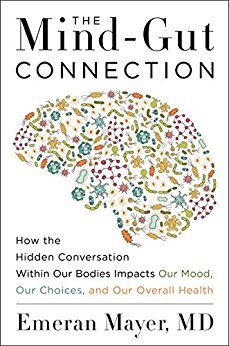More on this book
Community
Kindle Notes & Highlights
by
Emeran Mayer
Read between
March 13 - April 16, 2017
different types of stress can temp...
This highlight has been truncated due to consecutive passage length restrictions.
the number of lactobacilli in the stool of st...
This highlight has been truncated due to consecutive passage length restrictions.
Several laboratories have shown that
norepinephrine
can stimulate the ...
This highlight has been truncated due to consecutive passage length restrictions.
bacterial pathogens that can cause serious ...
This highlight has been truncated due to consecutive passage length restrictions.
stomach ulcers, and ev...
This highlight has been truncated due to consecutive passage length restrictions.
chronic stress stimulates the growth of many pathogens,
It also causes the autonomic nervous system in our gut to release stress signals that can reduce the thickness of the mucus layer lining the colon wall and make your gut leakier,
I suspect that some of these gut reactions associated with positive emotions are also associated with the release of distinct chemical messages to our gut microbes.
We already know that
serotonin, dopamine, and ...
This highlight has been truncated due to consecutive passage length restrictions.
are released into the gut interior, and they would be good candidates for such positi...
This highlight has been truncated due to consecutive passage length restrictions.
series of studies in recent years has suggested that patients on the
autism spectrum
may have an altered mix of gut microbes relative to individuals without ASD symptoms, including proportionally more of a bacteria group known as Firmicute...
This highlight has been truncated due to consecutive passage length restrictions.
Jonathan’s analysis revealed that he had th...
This highlight has been truncated due to consecutive passage length restrictions.
Up to 40 percent of patients with a diagnosis of ASD suffer from gastrointestinal symptoms, mostly altered bowel habits and abdominal pain and discomfort,
They commonly have elevated blood levels of the brain-gut signaling molecule serotonin.
In one of the best and most influential animal studies done yet,
injected pregnant mice with a substance that mimics viral infection and activates their immune
system. Young mice born of such mothers exhibit a range of altered behaviors that resemble those of people with ASD, including anxiety-like behavior, stereotypic repetitive behaviors, and compromised social interactions.
the young mice exhibited changes in their gut and the gut microbiota: an imbalanced mix of gut microbes, a leakier intestine, and greater engagement of the gut-based immune system.
investigators identified a particular gut microbial metabolite that was closely related to a metabolite that had previously been identified in the urine of children with ASD.
when they transplanted the stool of the abnormal mice into germ-free mice that behaved normally, the transplanted animals behaved abnormally.
they could make several (though not all) of the autism-like behaviors disappear by treating the affected mice with human intestinal bacteria called Bacteroides fragilis.
Bud Craig,
proposed that every emotion has two closely connected components:
sensory component (including gut feelings)
a...
This highlight has been truncated due to consecutive passage length restrictions.
action component (...
This highlight has been truncated due to consecutive passage length restrictions.
gut reactions). The sensor...
This highlight has been truncated due to consecutive passage length restrictions.
the purpose of every emotion is to maintain balance of the entire organism.
Damasio
elegantly formulated the
somatic marker hy...
This highlight has been truncated due to consecutive passage length restrictions.
According to Damasio’s theory,
we have so-called body loops that consist of signals traveling from the brain to the
body and...
This highlight has been truncated due to consecutive passage length restrictions.
his pioneering work and publications fundamentally changed our biological understanding of emotions and emotional feelings.
insular cortex,
can and does retrieve this somatic marker information.
Our brains can retrieve the edited video clips of how we felt when we felt vivid emotions, including the motiv...
This highlight has been truncated due to consecutive passage length restrictions.
when we experience an emotion as an adult, the brain does not need to feel sensations that describe what’s actually happening in the body.
Instead, it simply responds to a cue by accessing its library of emotional videos to generate a feeling.
It is only in the last decade that the exponential growth in our understanding of the gut microbiota and their interactions with the gut and the brain has forced us to expand these modern theories and include the gut microbiota as an essential third component in an expanded theory of emotion.
This theory postulates that our basic
brain-based emotional circuitry is large...
This highlight has been truncated due to consecutive passage length restrictions.
determined, present ...
This highlight has been truncated due to consecutive passage length restrictions.
epigenetically modified during...
This highlight has been truncated due to consecutive passage length restrictions.


